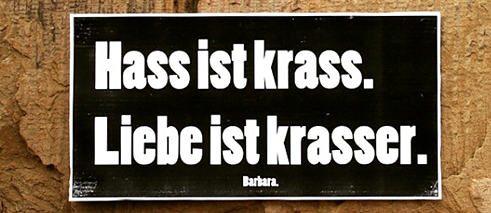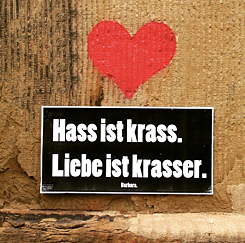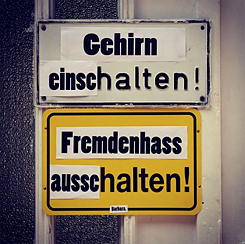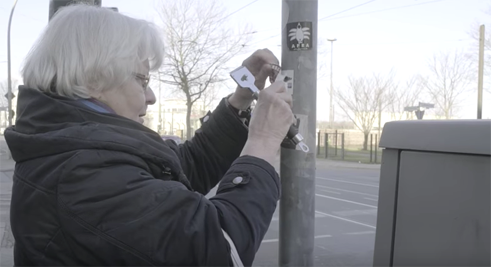Sticking to it: Barbara. and Irmela Mensah-Schramm

When one thinks of street art in Germany today, famous artists like ECB or Herakut often come to mind. But two new artists are giving German streets a different kind of look. Barbara. and Irmela Mensah-Schramm’s political engagement with stickers has transformed urban landscapes into vibrant sites of civic action and activism.
Following the ‘birth’ of modern-day graffiti in Philadelphia and New York City in the 1960s, unsanctioned street art staked a powerful claim on public space and expression. From Barbara Kruger to Jean-Michel Basquiat, artists left their mark on social debates by turning walls into textured commentaries. In doing so, they drew attention to questions surrounding the relationship between public space and private property, and further complicated issues of identity, anonymity, and the defiance of authority.
In Germany, iconic structures such as the Berlin Wall and subsequent East Side Gallery have long made German streets a beacon for wall-writers and artists alike. The 2017 opening of the Urban Nation Museum in Berlin, which The Guardian described as “the world’s first major institution built to champion and archive street art and graffiti,” reflects Germany’s enthusiasm for street art and shows how its fringe status has changed in the public eye, if not the greater art world itself.
This enthusiasm for German street spaces has escalated with increasingly polemical discussions and protests like the march on May 27, 2018 which pitted 5,000 supporters of Germany’s far-right-leaning party, the AfD, against 25,000 counterdemonstrators. Yet, the stakes of displaying one’s politics on the streets has also brought back a fascination with an old-fashioned public medium: the political sticker. Easy to use and quicker than scrawling a longer message by hand, stickers stuck onto public surfaces have become such a focal point that the Deutsches Historisches Museum in Berlin even hosted a 2016 exhibit titled: “Sticky Messages: Anti-Semitic and Racist Stickers from 1880 to the present,” which set out to educate citizens about the significant role that political stickers have played in the past and present.
For artists and activists Barbara. and Irmela Mensah-Schramm, the emergence of extremist hate-stickers has served as a call to action: to re-claim public spaces with imaginative messages of hope, wit, or, in many cases, a fresh start.
#Stickermania: Barbara.
 © Barbara.
The sticker artist known as Barbara. (spelled with a period) is probably the most famous anonymous German artist alive today. Barbara. has amassed over 650,000 followers on Facebook and 360,000 followers on Instagram. In 2016, Barbara. won the illustrious Grimme Online Award for street art in 2016. But who is Barbara. and what makes her stickers so beloved?
© Barbara.
The sticker artist known as Barbara. (spelled with a period) is probably the most famous anonymous German artist alive today. Barbara. has amassed over 650,000 followers on Facebook and 360,000 followers on Instagram. In 2016, Barbara. won the illustrious Grimme Online Award for street art in 2016. But who is Barbara. and what makes her stickers so beloved?The identity of Barabara. is unknown. As her Facebook page proclaims, “I want to remain anonymous” (@ichwillanonymbleiben), which has invited comparisons to Banksy and added to the intrigue surrounding the art-activist’s identity. In addition, Barbara. has not specified a gender pronoun; instead, Barbara. identifies as a Mensch and gave me permission to use she and her for this article. What is very widely known, however, is Barbara.’s adhesive form of art-activism in German cities from Hamburg to Heidelberg and beyond.
Since Barbara. considers urban spaces mirrors for public attitudes, she has been making these spaces friendly, welcoming, and humorous, one sticker at a time. Barbara. traces her passion for stickers back to her childhood when she first placed a sticker over a swastika. Since then, the name Barbara. has become a house-hold name brand of clever civic action. Some slogans like “I stick, therefore I am.” (Ich (k)lebe, also bin ich.) playfully link the motif of the sticker medium to existential philosophy and social praxis all in one. Other slogans repurpose letters on public signs to creatively generate new forms of messaging.
The popularity of Barbara.’s stickers on social media has also translated into the world of publishing. A recent book series from the Bastei Lübbe publishing house showcases photographs of Barbara.’s street art in two books: “This Commanding Tone Hurts My Feelings” (Dieser Befehlston verletzt meine Gefühle) and “Hate is Crass: Love is more Crass” (Hass ist krass. Liebe ist krasser). Her latest book is titled “But not in this Tone, Buddy!” (Aber nicht in diesem Ton, Freundchen!) and hit the book stores in April 2018, thus adding a longer-lasting print legacy to a fleeting artistic sticker medium.
 Turn on your brain - Barbara.
| © Barbara.
Turn on your brain - Barbara.
| © Barbara.
“Polit-Putze”: Irmela Mensah-Schramm
Whereas Barbara.’s art-activism hinges on stickers that add messages of wit and positivity to walls and signs, another art-activist has made scraping stickers off of walls and signs the focus of her activism. Retired teacher Irmela Mensah-Schramm has long made a vocation out of keeping Germany’s streets free of hate. Armed with a scraper and nickname of the “Polit-Putze” (political cleaner), Mensah-Schramm travels around Germany cleaning up German walls from hate-speech, a style of engagement which reveals her commitment to fostering a more understanding society and which has led to numerous humanitarian awards including Göttingen Peace Prize, Silvio Meier Award, and Order of Merit from the Federal Republic of Germany.While Mensah-Schramm’s fame stems from her commitment to removing hate stickers, the lasting effect of her work has to do with her documentation of every individual extremist message, which numbers well over 72,000 instances. Mensah-Schramm’s personal collection of hate-speech serves as its own form of public archive to record when, where, and how hate has spread through German streets and how her peaceful counter-activism continues to challenge it.
 Kopf in den Wolken - Neufundland
| © Neufundland, Still from the video "Kopf in den Wolken"
This past February Mensah-Schramm’s work took on a new urgency when she teamed up with German pop band Neufundland to make a music video titled “Kopf in den Wolken” (Head in the Clouds), featuring her at work. However, because her work takes place in public spaces, the filming of the music video was continuously interrupted by far-right agitators, who threatened the camera crew and Mensah-Schramm herself. Although this disturbing development has put the filming on hold for now, it has not impeded Mensah-Schramm’s ongoing engagement to scour hateful stickers from German streets.
Kopf in den Wolken - Neufundland
| © Neufundland, Still from the video "Kopf in den Wolken"
This past February Mensah-Schramm’s work took on a new urgency when she teamed up with German pop band Neufundland to make a music video titled “Kopf in den Wolken” (Head in the Clouds), featuring her at work. However, because her work takes place in public spaces, the filming of the music video was continuously interrupted by far-right agitators, who threatened the camera crew and Mensah-Schramm herself. Although this disturbing development has put the filming on hold for now, it has not impeded Mensah-Schramm’s ongoing engagement to scour hateful stickers from German streets. Whether sticking up or scraping off political messages, the sticker activism of Barbara. and Irmela Mensah-Schramm reminds us of important commonalities between civic engagement, street art and the ongoing effort to make our public surroundings a better place.